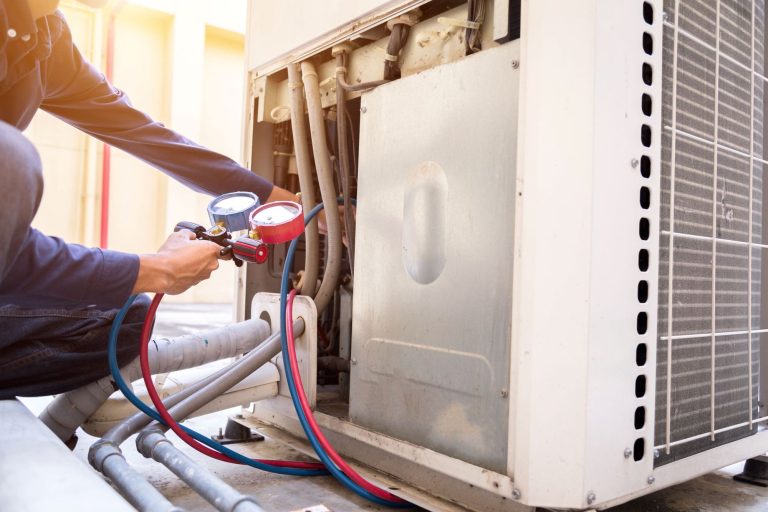As the weather warms up and the trees start budding, it’s time to start thinking about your HVAC system.
Spring is the perfect time to perform regular maintenance tasks to ensure that your heating, ventilation, and air conditioning system is operating at maximum efficiency. When it comes to HVAC, spring maintenance is essential.
Follow this spring HVAC maintenance guide to keep your system in top shape all season long. Also consider hiring a professional like Anderson Air to help you conduct your spring maintenance and prepare for summer.
1. Replace air filters
The first item on your spring HVAC maintenance list should be to replace all of your system’s air filters. Air filters trap dirt, dust and other pollutants as the air circulates in your home, and they should be replaced every month to every three months, depending on usage.
A filter that is clogged or full of dirt can reduce airflow and lead your system to overwork itself. This can lead to increased energy bills and potentially costly repairs.
2. Check and clean air ducts and vents
Here’s another key thing to add to your spring HVAC maintenance to-do list. Your air ducts and vents can also accumulate dirt and dust over time, leading to reduced airflow and diminished indoor air quality. Spring is an excellent time to check your ductwork for signs of leaks, cracks or gaps, and seal any problems you find.
Additionally, remove vent covers to clean out any dust or debris that has collected, ensuring that the air flows freely and cleanly throughout your home.
3. Inspect outdoor unit
Your outdoor unit can also accumulate dirt, debris or foliage over the winter, which can restrict airflow and reduce efficiency. Remove debris around the outdoor unit and clear away any shrubs or other foliage that may be blocking it.
Additionally, check for any damage to the unit or the surrounding area, such as bent fins or obstructed vents, that could impair its performance.
4. Clean and inspect coils
The coils in your system also require regular cleaning and inspection to maintain peak performance.
Clean both the evaporator and condenser coils using a soft brush, gently removing any dust, dirt or even debris that may have collected on the surface. Inspect the coils for signs of damage or corrosion and make any necessary repairs or replacements.
5. Check thermostat settings
The temperature settings on your thermostat can have a significant impact on energy usage and overall system performance. Check that your thermostat is set accurately and efficiently for the season. If you’re not sure how to adjust your settings, consider consulting with a professional HVAC technician for guidance.
6. Test system performance
Before the weather gets too hot, it’s a good idea to test your air conditioning system’s performance to ensure that it’s functioning correctly. Turn your system on and check the temperature of the outgoing air.
If the temperature is warmer than it should be, or if you hear strange noises or notice any other issues, it may be time to schedule a professional inspection or maintenance visit.
7. Check refrigerant levels
Your air conditioner’s refrigerant levels are critical to its overall performance. Low refrigerant levels can affect your system’s energy efficiency, cause your system to work harder than necessary, and lead to costly damage down the line.
Consider scheduling a professional inspection to ensure that your refrigerant levels are adequate and address any issues before they become significant problems.
8. Clean evaporator drain
The evaporator drain in your air conditioning system can also become clogged with dirt or debris, which can lead to reduced efficiency and even damage to your system. Check the drain line and clear any blockages with a mild cleaning solution, such as white vinegar and water mixture.
9. Seal air leaks
If your home has air leaks, your HVAC system could be working harder than necessary to keep your home at a comfortable temperature. Use weather stripping or caulking to seal the gaps around the edges of windows, doors, and other areas where air may escape, reducing your energy usage and increasing the efficiency of your HVAC system.
10. Schedule professional maintenance
While performing these spring HVAC maintenance tasks can go a long way in keeping your system in good shape, it’s still recommended to schedule a professional maintenance visit at least once per year.
A professional HVAC technician can perform more in-depth inspections and identify potential issues that you may miss, ensuring that your system is functioning at peak performance and limiting the potential for costly repairs down the line.
Professional HVAC spring maintenance is the best way to keep your system in tiptop shape for the hot season.
Conclusion – The comprehensive spring maintenance HVAC systems need
Following this spring HVAC maintenance checklist can help ensure that your system operates at maximum efficiency, limiting energy waste and reducing the likelihood of costly repairs in the future.
Remember to replace air filters, clean ducts and vents, inspect your outdoor unit and coils, and schedule professional maintenance to keep your system in top shape during the summer months.

